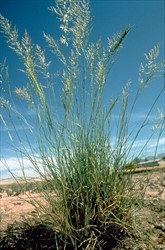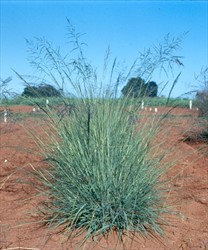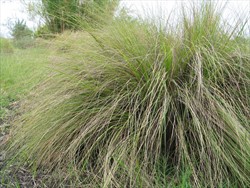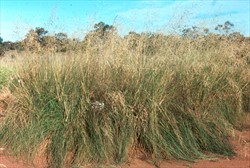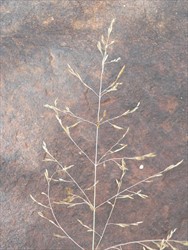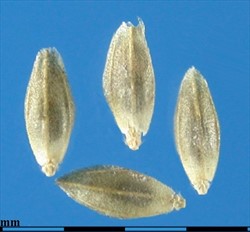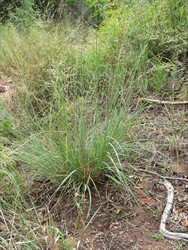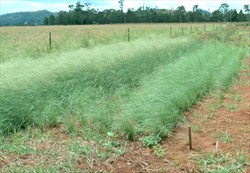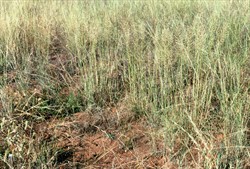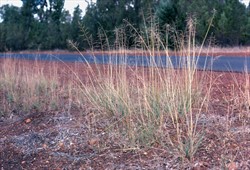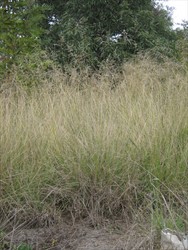Eragrostis curvula
Tropical Forages
Eragrostis curvula (Schrad.) Nees
Basionym: Poa curvula Schrad.; Eragrostis chloromelas Steud.; Eragrostis curvula var. ampla ined.; Eragrostis curvula var. conferta Nees; Eragrostis curvula var. valida Stapf; Eragrostis jeffreysii Hack.; Eragrostis robusta Stent; Eragrostis subulata Nees
Note: The taxonomy of this species is complex due to its morphological diversity. It is frequently referred as the E. curvula complex or E. curvula sensu lato (in the broad sense).
Family: Poaceae (alt. Gramineae) subfamily: Chloridoideae tribe: Eragrostideae.
Variable, tufted, deep rooted perennial with drooping leaves mostly concentrated at the base of the plant to 30 or 50 cm. Culms erect, 0.3‒1.2 (‒1.8) m tall, with fine, fibrous unbranched, stems, and glabrous nodes. Leaf sheaths keeled; basal sheaths strongly striate, densely to sparsely hispid below; ligule a rim of hairs 0.3‒1.0 mm long; leaf blades variable in colour from bluish to green, curling at the tip when dry, minutely hispid (rough on both surfaces), long, narrow and tapering, to 50 cm long and 1‒5 mm wide, rolled or flat. Panicle much branched, sometimes narrow and contracted, with branches appressed to the main axis but mostly loose and spreading, 6‒30 (‒40) cm long, 5‒10 (‒15) cm broad, the lower branches pilose in axils. Spikelets greyish-green, flattened, linear-oblong to linear elliptic, 3‒10 mm long and 1‒1.5 mm wide, comprising 4‒13 florets, breaking up from the base, the rhachilla persistent below but fragile above; caryopsis ellipsoid, 0.7 mm long. About 3.5‒5 million caryopses or 110,000 spikelets per kilogram.
M-A Groups
For general purposes, the complex has been divided into 6 broad morphological-agronomic types:
Curvula (Weeping lovegrass): weeping habit with long arching very narrow leaves, mostly basal; open panicle. Considered to be the least palatable type, along with CH type.
Conferta (Boer lovegrass): predominance of leaf over stem but leaves and plants shorter than curvula; short, compact inflorescence.
Robusta (sometimes further divided into Blue, Green and Intermediate)
Robusta Blue (RB): vigorous leafy plants with tall, thick stems and relatively broad, bluish-green leaves and large panicles.
Robusta Green (RG): moderately leafy plants; stems shorter and finer than RB; leaves dark green.
Robusta Intermediate: intermediate between RB and RG.
Cold-hardy (CH) lehmann type: procumbent growth-habit; superficial resemblance to E. lehmanniana stemmy with relatively more culm leaves than basal leaves.
Tall chloromelas: stems long and slender; leaves long, bluish green.
Short chloromelas: stems short and slender; leaves short, bluish green; basal leaves with curved, dead tips; similar to CH, but shorter and with finer stems.
Asia: 弯叶画眉草 wan ye hua mei cao, 垂愛草 (China); shinadare suzume gaya, wiipin gurabu gurasu (Japan)
English: African lovegrass, blue love grass, boer love grass (Conferta type), Ermelo lovegrass (Curvula type), weeping grass, weeping love grass, wire grass
Europe: kosmatka Africka (Croatia); éragrostide courbée (French); gekrümmtes Liebesgras (German); eragrostide curvula (Italian); Afrikanskt kärleksgräs (Sweden); salkım yalaf (Turkey)
Latin America: capim-chorão, falsa barba de bode (Brazil); pasto llorón (Argentina, Bolivia, Ecuador, Peru); amor seco curvado (Mexico); amor, eragrostis llorona, falsa barba de node, melena, milena, pasto llora amor (Spanish)
South Africa: bergsoetgras, blougras, blousaadgras, digsaad eragrostis, fyngras, hardegras, jongosgras, kaffergras, oulandergras, oulandsgras, renostergras, vleigras, fynvleigras, growwevleigras (Afrikaans); matolo, motolo, moseka, moseeka (Sotho); seritsoana (Zulu)
Native:
Africa: Botswana; Kenya; Lesotho; Namibia; South Africa (Cape Province, Free State, KwaZulu-Natal, Transvaal); Swaziland; Tanzania; Mozambique; Zambia; Zimbabwe
Naturalized:
Africa: Madeira Islands; Morocco
Asia: Armenia; Azerbaijan; Georgia; Turkey
Pacific: New Guinea
Australasia: Australia; New Zealand
Europe: Belgium; Germany; Portugal; Spain; Switzerland; United Kingdom
Northern America: Mexico; USA (Georgia, South Carolina, Texas)
South America: Argentina; Brazil (Federal District, Minas Gerais, Pará, Paraíba, Paraná, São Paulo); Chile; Uruguay
Cultivated:
Australasia: Australia
Northern America: USA
South America: Argentina
Forage
E. curvula is used for pasture and hay, but must be utilized when young to obtain real benefit.
Environment
Used for stabilisation of road verges and terraces, water discharge areas, and banks of earth tanks, and sown in strips for control of wind erosion. Weeping (curvula type) cultivars have been used for acid mine-spoil revegetation in South Africa and the USA. Boer lovegrass has been used for revegetation of overgrazed or brush-invaded, semi-arid ranges in parts of northern America.
Other
Some E. curvula types have been used as break crops to control rnematodes in maize (Zea mays L.), tea (Camellia sinensis (L.) Kuntze) and tobacco (Nicotiana tabacum L.).
Grows in grasslands and clearings in woodlands. Considered an important pioneer grass in its native habitat;
Soil requirements
Originates primarily from deep, sandy soils. It is mostly grown on well-drained, acid soils of sandy to loam texture. While it can be established on heavy clay soils it fails to persist in the longer term. It is best grown on soils with pH from 4.5 to 7.0, because it is susceptible to iron deficiency chlorosis on high pH calcareous soils. Optimum pH varies with genotype. The extensive root system can exploit depths to 5 m, but it is also adapted to relatively shallow soils (c. 20‒50 cm deep). Tolerant of moderate levels of salinity. Some genotypes at least (e.g. cv. Consol) are tolerant of high aluminium saturation of the exchange complex. Although distribution maps show it to be intensively present in southern Africa, it is not common in natural grasslands, but can be in dense populations in disturbed land e.g. trampled, heavily grazed or cultivation fallow. While largely found on poor sandy soils, it does respond to low applications of N fertilizer.
Moisture
E. curvula, a C4 species, occurs in areas with a predominantly cool season rainfall in southern Africa, with rainfall distribution gradually moving to summer dominance farther north. It can be grown in areas of low to moderate rainfall (400‒) 500‒1,000 mm (‒1,200 mm), extending to as low as 300 mm if sown in basins or contour furrows and mulched. It is very drought tolerant (conferta and robusta types generally >curvula types). The horizontal roots can spread to at least 1 metre, filling the surface soil between plants, making it very effective in using light rain and in preventing other plants from establishing. E. curvula does not grow in poorly drained soils and does not tolerate flooding.
Temperature
The distribution of E. curvula extends from near the equator to about 34º S and from sea level to 3,500 m asl, representing a range in average annual temperature from <14 to about 23 ºC. Optimum temperature for growth is between 17 and 32 ºC, although it still makes significant growth at 7 ºC, and in some genotypes, down to -10 ºC. Frost tolerance varies widely, some genotypes going dormant at the first frost (most CH types), while other (e.g. curvula types) remain green and potentially active through the first frosts, but with little active growth. Still other accessions, frequently robusta types, remain active and continue to grow through the first frosts. Winter survival (winter-hardiness) in severely frosted areas varies among genotypes. Those with intermediate growth strategy are usually the most winter-hardy, while those with a long growing season are rarely very winter-hardy. E. curvula has persisted in areas with mean minimum winter temperatures down to -5 ºC. Minimum temperature for reliable stand survival of the most winter-hardy cultivars is between -15 and -20 ºC (assuming appropriate management).
Light
Although it occurs in grasslands and clearings in woodlands, suggesting a preference for full light, it is said to have moderate shade tolerance.
Reproductive development
Flowering patterns vary with type. Curvula and conferta types normally flower in late spring and to a lesser extent, late summer, but rarely in mid summer. If a curvula type is mowed following flowering in late spring, it produces few or no additional heads until late summer. By contrast, the CH type commences flowering in spring, and continues to produce large numbers of inflorescences throughout the summer, with a much higher percentage of fertile tillers than in the curvula type.
Defoliation
Starts growth early in the season and continues until quite late. As foliage becomes fibrous rapidly, and seedheads emerge as described above, it is important to mow or graze regularly. Periodic mowing is beneficial if cattle are not able to maintain sufficient grazing pressure. Rotational grazing is not necessary to maintain stands of the curvula type, although in some circumstances it can be helpful. Defoliation can increase persistence when more heavily fertilized 'A-67' is subjected to summer drought. In this situation, failure to remove foliage results in depletion of available soil water and tiller/plant death. Defoliation can slow water use and improve chances of survival. In higher latitude extremes of adaptation, late-season defoliation can decrease persistence. Close late-season defoliation results in depletion of energy reserves in producing new growth at a time when they are needed for winter survival.
Fire
Prescribed burning is a practical and efficient management tool for maintaining stands. Herbage production and quality, density and uniformity of stand, and pasture utilisation are generally improved by burning.
Guidelines for establishment and management of sown forages.
Establishment
The very small seed size of E. curvula demands a clean fine seedbed for successful establishment. Seed can be broadcast or drilled, and covered to less than 1 cm. Rates of 1‒5 kg/ha seed give good stands with broadcast sowings, although this can be reduced to as low as 0.25 kg/ha for row planting. An inter-row cultivation of row-planted E. curvula during the first year helps it compete with weeds, although this is not necessary in subsequent years. Row spacing can be from 0.6 to 1.2 m. Good seedling vigour and rapid early growth contribute to ease of establishment.
Fertilizer
Survives on poor soils, but needs extra nitrogen for high production. In hay crops, potassium may also become necessary. Phosphorus does not seem to be as important as it might be with some of the panicoid grasses. If needed, fertilizer should be added prior to planting, with recommended rates of P and K. Nitrogen may be applied at this time at rate of 10‒20 kg/ha, with additional nitrogen applied as top-dressing once seedlings are well established. At the cooler extreme of its range, limited N fertilization can increase winter survival of curvula types.
Compatibility (with other species)
E. curvula is a pioneer species, and competes aggressively, particularly in disturbed situations, and in sandy soils.
Companion species
Grasses: Bothriochloa ischaemum, B. bladhii, Chloris gayana, Cynodon dactylon, Digitaria eriantha, Paspalum lepton.
Legumes: Aeschynomene falcata, Chamaecrista rotundifolia, Kummerowia stipulacea, Listia bainesii, Macroptilium atropurpureum, Medicago sativa, Melilotus spp., Ornithopus pinnatus, Stylosanthes guianensis var. intermedia, S. scabra, Trifolium subterraneum, Vicia spp.
Pests and diseases
None known.
Ability to spread
Spreads readily into disturbed areas. Often spread by roadside slashing, earthworks and motor vehicles.
Weed potential
E. curvula has become a serious weed of pasture, on road verges, and in cultivation, although the culpable type is rarely cited. Less palatable, prolifically seeding types develop large, viable soil seed banks, making them difficult to eradicate and very competitive with other pasture species. The problem perpetuates when the major types of disturbance, overgrazing and burning, are maintained. E. curvula has been listed as a weed in Australia, Chile, South Africa, Lebanon, Colombia, parts of the United States, New Zealand, Hawaii and Japan.
Nutritive value
Crude protein levels and IVDMD vary largely with age of material and nitrogen fertility of the soil. IVDMD values of 65% and 18% CP have been measured in young growth, compared with 50% and 6% in older material. Values as low as 40% and 4% for standover material have been measured. Hay harvested about 10 days after seed head emergence, has IVDMD and CP values of the order of 60% and 11% , respectively.
Palatability/acceptability
Acceptability to stock declines rapidly with age of regrowth, some genotypes becoming fibrous and unpalatable sooner than others. Of the groupings mentioned under "Morphological description", the 'conferta' types are the most palatable, followed by 'robusta', 'chloromelas' then 'curvula', with 'CH' the least palatable. However, the palatability of robusta germplasm is especially variable and important palatability differences exist within all types. Palatability is improved by fertilizing with N. Leaves become very fibrous and difficult for stock to break off or digest. Unless slashed or burnt periodically, stems and leaves are not utilised by stock except under heavy grazing pressure or where there is no pasture choice.
Toxicity
Not toxic.
Dry matter
Growing mostly in infertile soils under low rainfall, dry matter yields are generally low at 3–10 t/ha/year. Yields can be more than doubled through applications of 100–200 kg/ha N. In more favourable environments and with adequate nitrogen and sometimes irrigation, yields of 20–30 t/ha DM are achievable. While yields can be doubled by increasing cutting frequency from 4 to 8 weeks, any gains are lost to the rapid decline in feeding value.
Animal production
Heifers stocked at about 12/ha have produced a liveweight gain of 550 kg/ha over summer, and sheep 53/ha over 130 days produced a liveweight gain of 160 kg/ha. At lower stocking rates (1.5 steers/ha), animals can gain 0.7–1 kg/day during the growing season. Use of more palatable selections can produce 13% more liveweight gain than less palatable types. However, where they have been tested, robusta cultivars have not been more productive of animal product than the curvula types, 'Morpa' or 'Ermelo'.
2n = 20, 40, 50, 54, 60, 63, 70, 80. Basic chromosome number is x = 10. Diploid (2n = 20), polyploids, and aneuploid (2n = 63) types have been found. The diploids reproduce sexually while the polyploids are mostly pseudogamous, diplosporous apomicts. Apomixis is mostly obligate, sometimes facultative. Sexual and apomictic types have been found in the tetraploids.
The following chromosome complements have been identified:
1) 'conferta' : 2n = 20 (sexual), or 40 (apomictic);
2) 'curvula': 2n = 40;
3) 'robusta': 2n = 50–80;
4) aff. 'robusta': 2n = 20 (PI 299920);
5) CH (cold-hardy) type: 2n = 40;
6) 'chloromelas': 2n = 40, 80.
Seed crops are generally planted in rows to achieve larger seeds. It is possible to produce two crops per season, one started in April in the northern hemisphere (October in the southern hemisphere), and the other in August (February). Crops are started with 50–100 kg/ha N, along with other nutrients as required. It can be harvested with a header-harvester or a hand sickle when one-third of the head has turned brown. Seed yields of 30–225 (to >500) kg/ha have been reported.
Broadleaf weeds can be controlled in E. curvula with 2,4-D. Mature E. curvula plants are killed with glyphosate, which can be mixed with sulfometuron methyl where residues will not affect subsequent crops. Flupropanate, and oxyfluorfen are also effective. Several of the triazine herbicides, including atrazine, can be used for control of weeds (including weedy cool-season grasses). E. curvula seedlings are susceptible to these herbicides.
- Grows on low-fertility soils.
- Establishes easily.
- Good cold tolerance.
- Valuable in erosion control.
- Drought-hardy.
- Long growing season.
- Not adapted to heavy clays.
- Nutritive value declines rapidly.
- Has significant weed potential.
- Intolerant of waterlogging.
Bogdan, A.V. (1977) Tropical Pasture and Fodder Plants. Longman Inc., New York, USA. p. 136–139.
Fernández, O.A., Brevedan, R.E. and Gargano, A.O. (eds). (1991) Pasto llorón: Su biología y manejo. Universidad Nacional del Sur, Bahía Blanca, Argentina.
Gibbs Russell, G.E., Watson, L., Koekemoer, M., Smook, L., Barker, N.P., Anderson, H.M. and Dallwitz, M.J. (1990) Grasses of Southern Africa: An identification manual. Memoirs of the Botanical Survey of South Africa No. 58. Botanical Research Institute, Pretoria, South Africa.
Mynhardt, J.E., van Rooyen, M.W. and Theron, G.K. (1994) Competitive ability of two grass species: Anthephora pubescens and Eragrostis curvula. 1. Yield and biomass accumulation. South African Journal of Botany 60:261–268. doi.org/10.1016/S0254-6299(16)30601-9
Robinson, G.G. and Whalley, R.D.B. (1991) Competition among three agronomic types of the Eragrastic curvula (Schrad.) Nees complex and three temperate pasture grasses on the northern tablelands of New South Wales. Crop and Pasture Science 42:309–316. doi.org/10.1071/AR9910309
Voigt, P.W., Rethman, N.F.G. and Poverene, M.M. (2004) Lovegrasses. In: Moser, L.E., Burson, B.L. and Sollenberger, L.E. (eds) Warm-Season (C4) Grasses. Agronomy Monograph No. 45. ASA, CSSA, SSSA, Madison, WI, USA. p. 1027–1056. doi.org/10.2134/agronmonogr45.c32
Wan, C. and Sosebee, R.E. (2002) Tiller recruitment and mortality in dryland bunchgrass Eragrostis curvula as affected by defoliation intensity. Journal of Arid Environments 51:577–585. doi.org/10.1006/jare.2001.0939
'A-67' (PI 477012) Released in Arizona, USA. From north central Tanzania. Curvula type. Leafy, densely tufted, long-lived, with extensive root system and long, lax leaves. Greater forage and seed production and more cold-tolerant than the conferta types or E. lehmanniana. Used for range, pasture, and soil protection on a wide variety of soil textures where annual precipitation exceeds 350 mm. Probably the most widely naturalized type in the USA.
'A-84 Boer' PI 469222) Released in Arizona, USA (1950). From South Africa. Conferta type. Palatable, drought-resistant, but less winter-hardy than A-67, and most other genotypes. Longer lived than E. lehmanniana.
'Agpal' Released in South Africa (2000). From Kokstad, KwaZulu-Natal, South Africa (30.55º S, 2,100 m asl, rainfall 700 mm). Selected from the old Witbank type for superior palatability, fine stem and leaf, and early seeding ability. Dark green foliage, and finer-leafed than 'Ermelo'. Cold tolerant type, with culms to 1.8 m.
'Catalina' (PI 203347, used to develop PI 574519) Released in Arizona, USA (1969). From Cradock, South Africa (32.1º S, 25.6º E, 930 m asl, rainfall 312 mm). Conferta type. Selected for seedling drought tolerance. Adapted in semiarid and arid areas with a minimum annual rainfall of 300 mm. Superior to 'A-84' for ease of establishment, producing 30% higher yield of better quality than 'Lehmann'. Long-term survival similar to that of 'A-84'.
'Cochise' (PI 276033, CPI 99872) Released in Arizona, USA. A cold-hardy (CH) type, frequently listed as E. lehmanniana × E. trichophora or E. trichophora. Heads far more profusely than the curvula type, and is less palatable than the curvula type, except for a short time during spring prior to initial heading.
'Consol' (South Africa: B/53/52, Register No. 119; NSW S.C.S. 4663; APG 49986) Released in NSW, Australia. Institutional collection from South Africa. Origin Pniel, Western Cape Province, South Africa. 33º50' S, 320 m asl, rainfall 930 mm) A tetraploid (2n = 40), conferta type. Morphologically similar to 'A-84', 'Catalina' and 'Don Walter'. Selected primarily on the basis of palatability to sheep. More palatable than 'Morpha' and 'Catalina' which are in turn more acceptable to stock than 'Ermelo'. Basal leaf sheaths purple, striate, nerves somewhat indistinct, yellowish. Culms up to 60 cm tall, robust (to 3 mm diameter at the base), erect, nodes long, exserted, purple to olive green. Leaves glaucous, blue-green, 15‒25 cm long, up to 7 mm wide. Panicle olive-green, up to 15 cm long, narrow, contracted, with stiff lateral branches, usually less than 5 cm long, lowest branches not hairy in the axils. Seed orange to dark brown, approximately twice as long as broad, acute. Morphologically distinguishable from naturalized types, as well as being more palatable. Agronomically similar to 'Catalina'. Superior drought tolerance, persistence, frost hardiness and herbage production to most other warm season perennial grasses in adapted environment. Most active growth in spring and autumn. Tolerant of relatively high exchangeable soil aluminium (±30% saturation)
'Don Pablo', 'Don Juan' Released in Argentina; robusta types; adapted to drier areas.
'Don Eduardo' (robusta type) 'Don Carlos' (robusta type) 'Don Arturo' (Curvula type; similar to 'Ermelo'), 'Don Walter' (conferta type). Released in Argentina; all no longer in production.
'Ermelo' (PI 164917, 190312, 196355, 199060, 232986, 298985) Released in South Africa. From Ermelo district, Mpumalanga, South Africa (26.5º S, 1,700 m asl, rainfall 500 mm). Curvula type. Leafier and more palatable than naturalized types, staying green longer under moisture and temperature stress, and re-growing more quickly after grazing.
'Morpa' (PI 208994) Released in Oklahoma, USA (1970). From South Africa. Curvula type. Selected for winter survival and acceptability to livestock. Taller than naturalized ecotypes, with darker panicles, and slightly wider leaves. Used for pasture and hay. DM yields equal to or higher than those of other cultivars; contains less lignin and produces higher liveweight gains than naturalized types with both winter and summer grazing.
'OTA-S' Released in Oklahoma & Texas, USA. Conferta type from South Africa. Bred from 4 clones, three sexual clones from PI 299929 (2n = 40) and one a tetraploid from the cross PI 299928 (2n = 20) x PI 299929 (apparently derived from fertilization of an unreduced egg by pollen from the tetraploid PI 299929).
'Renner' (PI 591633) Released in Texas, USA. Leaves blue-green and broad (up to 6 mm wide). Seed reddish-brown with a black hilum; much smaller than those of common types. Seed prone to shattering. Selected for higher palatability than 'Ermelo'. Remains green during drought and heat, autumn and winter and into maturity. Relatively winter hardy compared to other robusta germplasm. Less winter-hardy than 'Ermelo' or other curvula type cultivars. No longer available.
'Tanganyika' Released in Argentina (See 'A-67'). Curvula type. Adapted to moister areas. Probably the most widely naturalized type in Argentina.
'Umgeni' Released in South Africa (1995). Similar to 'Ermelo'; more suitable for hay.
Note: This cultivar list is by no means exhaustive, further varieties having been released primarily in USA, Argentina and South Africa. Many are now redundant.
PUK E238, PUK E422, PUK E427, PUK E916 Selected in South Africa by Potchefstroom University in the Bethlehem area.
CPI 30380 Selected in Queensland, Australia. Robusta type, highest yield.
